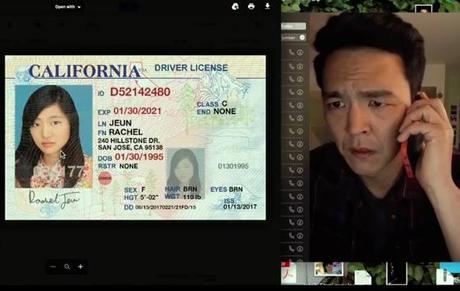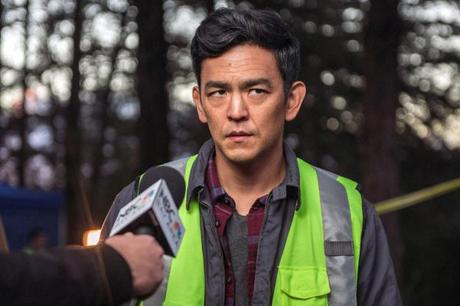Searching, which is filmed entirely from the point-of-view of computer screens and stars John Cho as a father performing some next-level internet sleuthing while searching for his missing teenage daughter, is somehow the first mainstream Hollywood thriller to be led by an Asian man.
For some, that might be all it takes to want to support Searching and celebrate its historical significance in the push for more diversity on film. For others, that's nice and all, but is it actually a good thriller? Does John Cho keep up his current hot streak after his multi-layered performance as the beleaguered father on The Exorcist: Season 2 ( my review) and heartwarming turn opposite Haley Lu Richardson in last year's underseen Before Sunrise-esque Columbus? Or is Searching a giant misstep, a failed proof-of-concept for the notion of setting a film entirely in computer screens and/or building a thriller around an Asian lead?

Luckily, it's the former, not the latter. Searching is a wonderfully tense thriller which continually advances its story through the use of computer screens instead of simply sticking there because it can and looks cool. If done more traditionally, the "my daughter is missing" story laid out in the script probably wouldn't completely stand out from the crowd, apart from the ethnicity of its cast. However, when married to its still-unique central concept it gains an astonishing immediacy.
Getting past my skepticism.I must admit, though, I was initially reluctant to go on this journey with Searching. We all spend, on average, 10 hours of our day in front of various screens, including smartphones, tablets, computers, and televisions. The latest generations of smartphones are so advanced you can now film entire movies on them and fool most audiences into thinking you actually used more advanced camera equipment. As such, it only makes sense that a new subgenre of film would develop to experiment with setting stories entirely on the black mirrors which populate our waking lives. In fact, Unfriended already tried this out 4 years ago. However, I needed some convincing this storytelling device could actually be cinematic and not just a gimmick.
So did John Cho.
Ditto for the film's director and co-writer Aneesh Chaganty.
The production history.This all started when the Russian production company behind Unfriended approached Chaganty's producing partner and co-writer Sev Ohanian with a pitch to do use the technology and techniques they pioneered on Unfriended and apply it toward a collection of short films which could be re-packaged as a feature. Having first met at USC's film school, Chaganty at that point had moved on to working in Google's Creative Labs division in New York and Ohanian was already a successful producer behind Ryan Coogler's breakthrough first feature Fruitvale Station. They were skeptical.
As Chaganty told KCRW's The Business, "We came up with an idea for a short film that was an 8-minute version of this movie, Searching, that we thought was cinematic and cool and fun, but most of all, not a gimmick. Watching the other movies, they didn't feel like they really needed to be told this way, they were just made because they could be told this way. That was a big gap for us to cross."
The breakthrough came when they thought up the opening scene, which Chaganty describes as " Up meets a Google commercial." 16 years of the family's life is told through their desktop history. It starts with John Cho's wife Pam (Sara Sohn) creating a separate WindowsXP profile for their new daughter Margot (Michelle La), and it ends with Cho creating a program for Pam's funeral, whose ultimately losing battle with cancer is shown to us through email exchanges, calendar planning, MySpace postings which gradually turn into Facebook updates, and .wmv format home videos.
Once this had been conceived, the rest of the film and the inventive ways to use the technology fell into place.
The uphill battle of convincing John Cho.Chaganty and Ohanian were on board, but Cho wasn't, even though the part of David Kim was actually written for him. "I loved the script. I just wasn't sold on doing it on screens," he told KCRW. "In fact, even during the filming of the movie I kept saying, 'Why don't we stop this whole screen business'."

Cho actually passed on the project. Multiple times. Chaganty's passion and continued pursuit of him eventually convinced Cho to take a creative leap of faith. Debra Messing, who plays the detective working with Cho to track down his daughter, was much easier to convince.
Lack of face-to-face contact sometimes shows.Not surprisingly considering how infrequently his character talks with anyone face-to-face, the actual filming experience was a lonely one for Cho, but it was also remarkably brief. Searching was shot in less than two weeks. The true heavy-lifting fell to the editors and production team who had to spend months creating David Kim's digital world.
At times, this lack of human connection is entirely the point of the story. David's failings as a father to properly deal with his own as well his daughter's grief led her to seek solace in the arms of digital strangers online. At other times, though, Cho or Messing's lack of an actual screen partner leaves them a bit lost in this grand acting experiment. As a result, Cho's mostly compelling mental and emotional exhaustion occasionally translates into the type of melodramatic yelling into phones that feels like an actor slightly over-compensating. Messing, by contrast, is restrained to the point of wooden.
How they do and sometimes do not root the technology in character.
Beyond that, Chaganty and Ohanian's script makes a couple of cheats in its "everything's on a computer screen" experiment, using TV news footage to impart key exposition once news of Margot's disappearance goes public. Searching is very good about rooting every second of its digital world in who exactly is the one looking at the screen at any given moment. The answer to that question is almost always John Cho. So, when it switches mid-movie from anchoring everything to Cho to a free-wheeling display of the general public becoming obsessed with Margot's case the effect is jarring, albeit also ingeniously accurate in its depiction of the triviality and artifice of internet fame (a girl we know didn't care about Margot becomes internet famous by posting a heartfelt tribute to her on YouTube while claiming to be her best friend).
THE BOTTOM LINEWhatever quibbles I have with Searching are just that - quibbles. Because this is ultimately a fantastic film which takes what could so easily be a gimmick and uses it to perfectly reflect the reality the majority of us actually experience through our computers. It maps that relatability onto a solidly-paced, suspenseful thriller with a solid central performance and mostly satisfying twists and turns.
RANDOM PARTING THOUGHTS- Ah, WindowsXP. It's been so long.
- Great running joke about no one ever using their computer's pre-installed Norton Antivirus trial software.
- First time I've ever seen the "big wall of crazy" trope applied to a computer screen background.
- Pay attention to the crawl at the bottom of all the TV news footage. That's where all the easter eggs live, including a shout-out to M. Night Shyamalan and a blurb about a Hollywood producer being the lead suspect in the death of a film editor. Working so hard to bring this to the screen while cooped up in editing suites, they probably did sometimes feel like killing each other.
- Searching also pulls double duty as a helpful tech demo for how to perform a Google Image Search, use backup email accounts to retrieve social media passwords, livestream video, import pictures into Excel, turn off distractions on an iMac, make a FaceTime call, and create unique destination names on Google Maps. Plus, ya know, how to try to find your missing daughter.
What about you? Have you seen Searching yet? Are you still skeptical about it truly being anything other than a gimmick? Is this what we all meant with that #StarringJohnCho hashtag from years back? Let me know in the comments.

